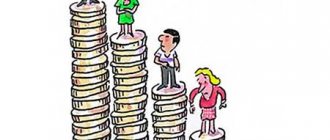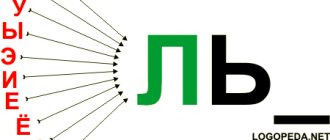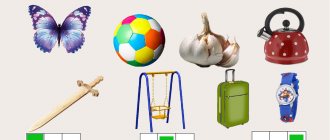Interactive simulator “C-Ch Differentiation”
Explanatory note
Author
: Kulyasheva Oksana Igorevna.
Place of work
: State educational institution of the Komi Republic “Special (correctional) boarding school No. 8” in the village of Koslan (GOU RK SKSH-i No. 8 in the village of Koslan).
Job title
: teacher speech therapist.
Resource name
: Interactive simulator “Differentiation of letters C-C”.
Item
: Speech therapy: pronunciation, written speech.
Class
: 3-5 class VIII type SCS.
Practical use
: the development can be used in a lesson - frontally and in subgroups, in an individual lesson, at home to differentiate the letters C-C.
Minimum hardware requirements
: computer.
Minimum requirements for software resources
: MS Office Excel program.
Description of the development:
The work was completed in MS Office Excel and is intended to develop the skill of differentiating the letters C-C for students in grades 3-5 of the VIII type secondary school.
The work contains 4 main sheets:
- Table of contents
This sheet provides instructions on how to complete the work and highlights tasks using hyperlinks. You can also move from task to task by “clicking” on the corresponding field at the bottom of the page (list of sheets).
- "Write the correct letter"
There are 8 pictures, under each of which there is one highlighted cell. When you “click” on a cell, a list of two letters opens – C and Ch. You must select the desired letter. If all the letters of the task are chosen correctly, the word “Well done” appears at the bottom. Otherwise (even if there is only one mistake) – “Think again.”
PICTURES: cucumber, butterfly, zucchini, button, garlic, pepper, egg, stove.
- “What kind of bird?”
This task is a set of five pictures depicting birds, under which there are empty cells according to the number of letters in the word. You must enter the name of the bird in the empty cells. If the spelling is correct, in the table located to the right of the main field, opposite each task the answer is displayed: “YES” or “NO”. In this case, until the word is completely typed, the answer “NO” is displayed. As soon as the word is typed, the opposite answer is displayed (the task was completed correctly), or “NO” remains.
Below there is an automatic counting of correctly and incorrectly signed pictures. Based on the number of correctly signed pictures, the result is displayed: “Well done” or “Think again.”
PICTURES: tit, seagull, siskin, swallow, starling, chicken, rook
.
- “Complete the words”
This sheet presents text in the words of which the letters C or CH are missing (17 letters in total). You need to enter these letters in the selected cells. While completing the task, an automatic count of both correctly placed letters and the number of mistakes made occurs.
- If you need to clear a cell from an incorrectly typed letter, “click” on it and press the “ delete ”
- When completing the task, the request “Save changes?” select "Don't save"
Links to sources
:
- Poem – Uspensky M.B. Correctly, smoothly, beautifully we learn to say: In 3 books. Book 3: A guide to speech development: For preschoolers and junior schoolchildren. class / M.B.Uspensky, L.P.Uspenskaya. – M.: Astrel Publishing House LLC: AST Publishing House LLC; St. Petersburg: SpetsLit, 2002. – 255, [1] p.: ill.
Images:
- Chicken
- Seagull -
- tit -
- Rook -
- Martin -
- Starling -
- Chizh -
- Cucumber -
- Button –
- Butterfly -
- Stove -
- Garlic -
- Zucchini -
- Pepper -
- Egg -
Speech therapy lesson on differentiating sounds and letters C—C
Sections: Speech therapy
Goals:
1. Correctional and developmental:
- development of phonemic awareness;
- development of thinking, attention, memory, visual perception.
2. Educational:
- the ability to distinguish the sounds Ch, C by articulation;
- expansion and activation of the dictionary based on the topic “Birds”;
- differentiation of sounds and letters C, CH;
- exercises in correctly reading words with the letters C, C;
- mastering the concept of the meaning-distinguishing role of the letters C, CH;
- ability to navigate in space;
- developing skills to work according to instructions.
3. Educational:
- nurturing interest in learning.
Equipment:
- workbooks;
- mirrors;
- pictures of birds;
- demonstration cards depicting the letters Chch, Ts;
- table with letters.
Progress of the lesson
Organizing time.
(Students stand near their desks.)
Speech therapist:
The first one to sit down will be the one who clearly and clearly repeats the tongue twister: “The black hen has four chickens.”
(Students complete the task.)
Speech therapist:
What sounds are most often repeated in a tongue twister?
Students:
Sounds [h] and [ts].
Speech therapist
(hangs demonstration cards with pictures of letters on the board): What letters will we talk about in class?
Students:
About the letters Ch and C.
Working with mirrors.
A comparison is made of [ts] and [h] in terms of articulation with clarification of the sound composition: [ts] = [t] + [s], [h] = [t'] + [w'].
Speech therapist:
Guys, let's look in the mirrors and find the differences in the articulation of the sounds [ch] and [ts].
(Students complete assignments.)
| Difference | [H] | [Ts] |
|
|
|
Correlation of sounds with letters.
Speech therapist:
Guys, listen to the poems:
The letter C is a hook at the bottom, like a barrel with a faucet. Here is the letter C: With a claw at the end. A scratchy claw, like a cat's paw. He confused the chizhik with the four and read: “Four chizhik.” Yes, you decided correctly, we write H as four. Only with numbers, friends, We cannot confuse letters.
Speech therapist:
Guys, what else do you think the bottom element of the letter C looks like?
Students:
On a chain link and on a heron's leg.
Speech therapist:
What about the top element of the letter H?
Students:
On the wing of a seagull and on the spout of a teapot.
Development of phonemic awareness.
Speech therapist:
Now I will pronounce syllables and words with the sounds [ts], [h]. If you hear the sound [h], then raise your hand up, if you hear [ts], lower it down.
Tsa, chu, och, ec, qi, chi, hour, goal, chain, kidney, ring, wheelbarrow, handkerchiefs, mirror, finger, boy.
(Students complete assignments.)
Didactic game "Chicken".
The game is aimed at developing visual perception.
Speech therapist:
Guess the riddle: “He cackles, clucks, calls the children, gathers everyone under his wings.”
Students:
This is chicken.
Speech therapist:
Right. Chicken is a domestic bird. She lives in a chicken coop and sleeps on the roost. She walks around the yard and collects grains. But our chicken is unusual; instead of grains, it will collect letters. If the chicken collects them correctly, she will get a whole word. Listen carefully to my commands and write down the letters that the chicken will collect, and at the end of the journey you will be able to read the resulting word.
| B | IN | G | D | E | AND |
| Z | AND | b | TO | L | E |
| M | N | Yo | Y | C | Kommersant |
| TO | ABOUT | L | U | F | I |
| E | H | P | Sh | YU | SCH |
The first letter that the chicken collected was C. Then she went to the left and stopped - Y. Down, down, left – P. Up – L. Up – E. Left – N. Down – O. Down – H. Left – E. Up – K.
- What word did you come up with?
Students:
Chicken.
Speech therapist:
What is the first letter and what is the eighth letter in this word?
Students:
The first letter is C, and the eighth is Ch.
Speech therapist:
Let's write the combination tsch, tsch to the end of the line, saying it out loud.
(Students complete the task.)
Physical education moment.
Speech therapist:
Well done. Now we will rest a little.
Girls and boys are jumping like balls. (Jumping on two legs.) They stomp their feet, (They stomp their feet.) They laugh merrily. (Pronounced: ha-ha-ha.
Speech therapist:
Guys, what other birds do you know that have the sounds [Ts] and [H] in their names?
Students:
Starling, tit, siskin, heron, gull, rook.
(The speech therapist hangs pictures of birds on the board.)
Encryption of words.
Speech therapist:
Well done! Now you will write these words in your notebook, drawing a triangle instead of the letter C, and a square instead of the letter C.
At the end there is a test: students read the words together.
Game "Big-small".
Speech therapist:
Now let's play the game "Big-Small".
A big tit
and
a little tit
were talking (the words are written on the board).
| Great tit speaks:
| A little titmouse speaks: - ring? ? ? ? |
Students:
Porch, chicken, egg, chick.
Speech therapist:
What sound Ts or Ch sounded in large objects? And in small ones?
Students:
The sound C sounded in large objects, and the sound Ch in small objects.
Speech therapist:
Now write these words down in your notebook in two columns.
Repeat after me.
Speech therapist:
Now I will read pure sayings to you, and you will repeat them after me.
- Tsa-tsa-tsa - chicken.
- Chi-chi-chi - rooks.
- Cha-cha-cha - seagull.
- Tsy-tsy-tsy - chicken.
- Chi-chi-chi - chizhi.
10. Summary of the lesson.
Speech therapist:
That's the end of our lesson. Let's remember what we did in class. How to distinguish between the letters C and CH? What tasks did you like best?
(Students answer questions.)
Bibliography:
- Anishchenkova E. S. A practical guide to correcting sound pronunciation in children for speech therapists and parents. Moscow, AST "Astrel", 2007.
- Gadasina L. Ya., Ivanovskaya O. G. Effective lesson planning for correcting the pronunciation of sounds. St. Petersburg, “KARO”, 2009.
- Pimenova T.I. I want to reprimand... St. Petersburg, “KARO”, 2006.
- Uspenskaya L.P., Uspensky M.B. Learn to speak correctly. Moscow, “Enlightenment”, 1995.
29.03.2010
xn--i1abbnckbmcl9fb.xn--p1ai
“Differentiation of sounds [TS-CH] in words”
Topic: “Differentiation of sounds [TS-CH] in words.”
Goals:
1. Achieve correct articulation and pronunciation of sounds.
2. Develop sound attention and phonemic perception: learn to hear sounds in words, differentiate by ear, correctly articulate and differentiate letters in writing.
3. Develop the articulatory apparatus and fine motor skills of the fingers.
4. Develop visual perception.
5. Develop the ability to work according to verbal instructions.
6. Summarize and consolidate knowledge on the lexical topics “Animals” and “Birds”.
Equipment:
individual mirrors, notebooks, pens, pencils, individual cards, subject pictures, signal cards, table of syllables, letter symbols, handouts (two pieces of wire for each student).
Progress of the lesson.
1.
Organizing time.
Greetings. Checking workplaces. “Guys, in today’s lesson a lot of interesting and instructive things await you. Wish you luck! In the last lesson, we started working on the sounds [Ц], [Ч] in words .
topic : “
C-Ch differentiation in words
.”
Tasks.
We will continue to develop the speech apparatus; learn the correct articulation of sounds [Ц], [Ч]; learn to hear these sounds in words, as well as distinguish the letters C, C in writing; Let's repeat the gymnastics for the eyes and fingers; Let's consolidate knowledge about animals and birds.
2.
Before we get started, let's train our speech apparatus.
Prepare your mirrors. Articulation exercises
: “Fence”, “Tube”, “Painter”, “Clock”, “Slide”, “Tease”. Practicing the correct articulatory structure of the sounds [Ts], [H].
3. Reinforcing correct sound pronunciation
in pure language.
“The turtle, not bored, sits for an hour with a cup of tea.”
“The flowers in the flower garden bloom all summer long.”
“Four little black little devils were drawing a drawing in black ink.”
“The spring water is clean and transparent, it flows into the river, murmuring and playing.”
“They ring it with a ring, galvanize it with zinc, cordon it off with a chain, attach trailers.”
“Clock-clack, hooves clatter! Chok-chok the heel is clicking like that! Let the tongue say the words “ink” and “water” clearly.”
4.
Well done! And I know that you really like to play the game “Echo”, because you have already learned to isolate the sounds [C] and [CH] in syllables. Shall we play? (The speech therapist asks students to identify those syllables in words in which these sounds are heard. Students repeat the syllables three times.)
Ring-tso, tso, tso; keys - chi, chi, chi; casket, casket, casket; I don’t want - choo, choo, choo; sun, sun, sun; strongman - ach, ach, ach; pod-chok, chok, chok; Well done, well done, well done, well done.
5.Characteristics of sounds
.
So, the sounds [C], [Ch]. What are they? What do they have in common, and how are they different from each other? What letters are they denoted by? How do letters differ from sounds? Do you know that you can not only see and write letters, you can make them yourself.


